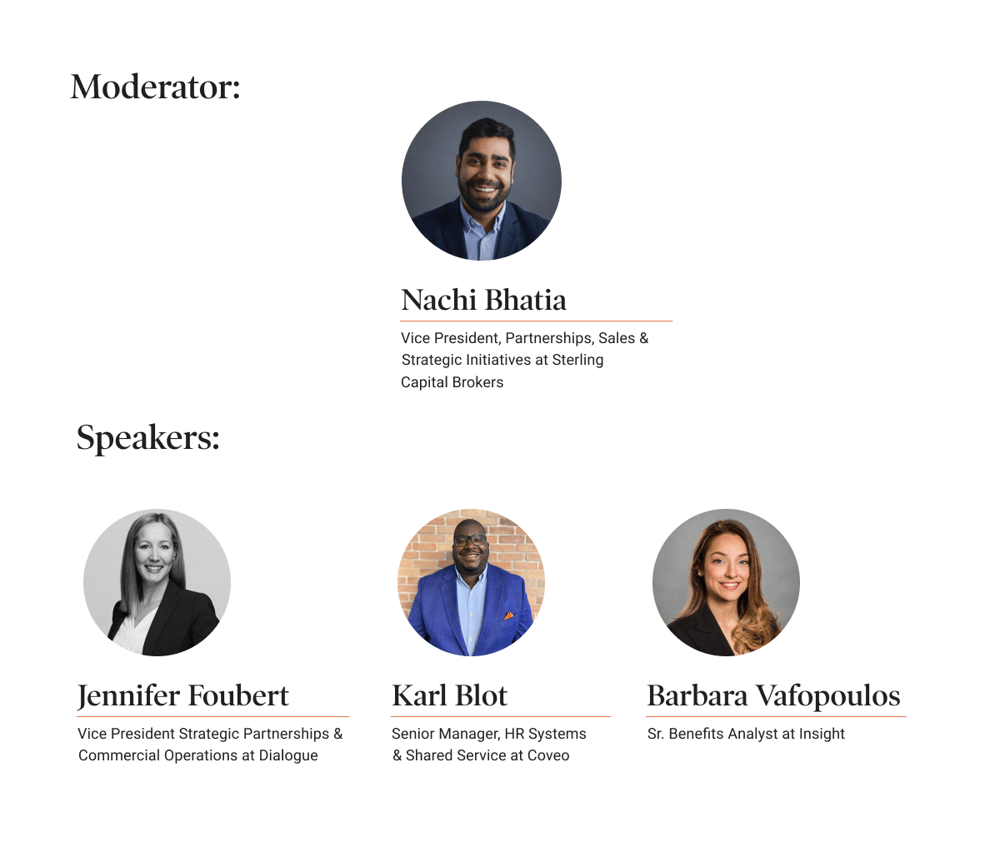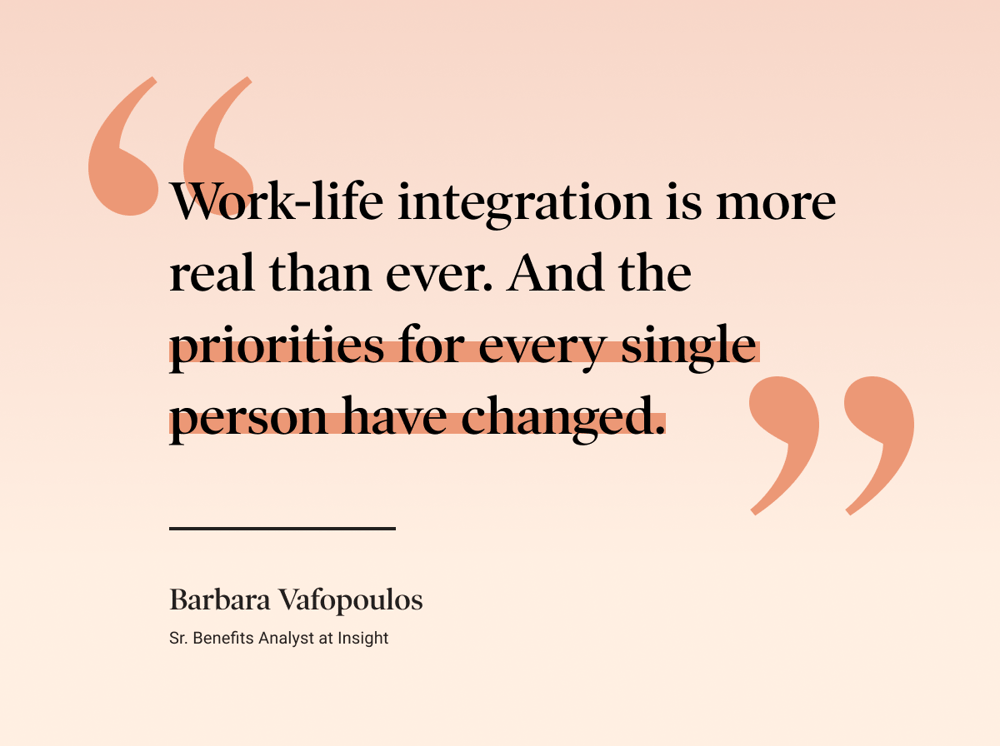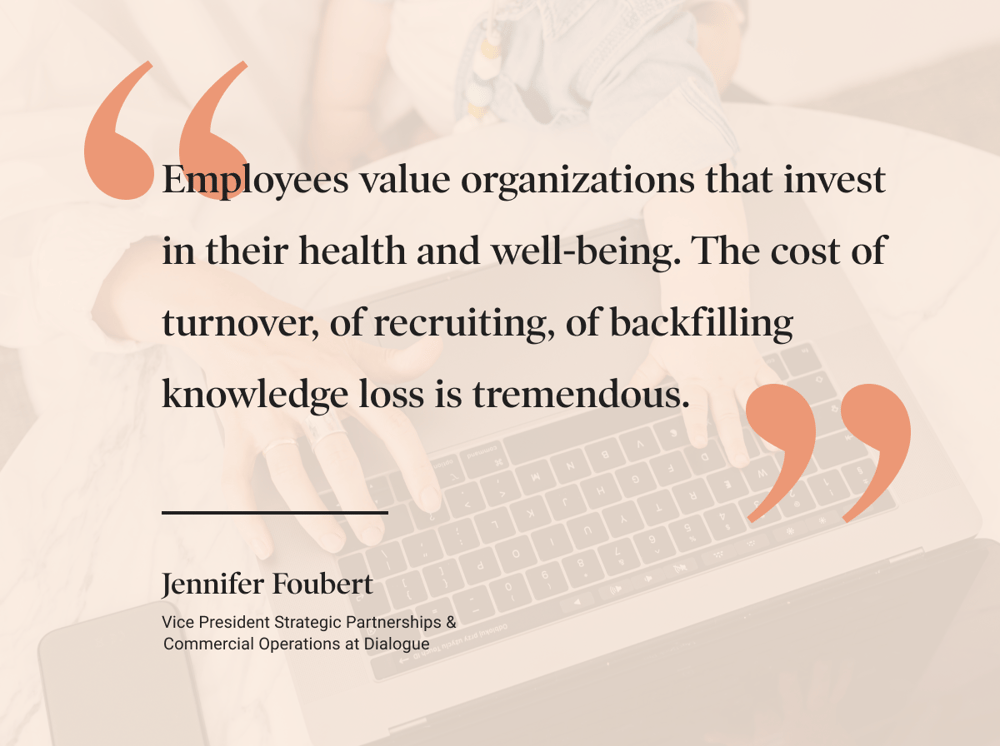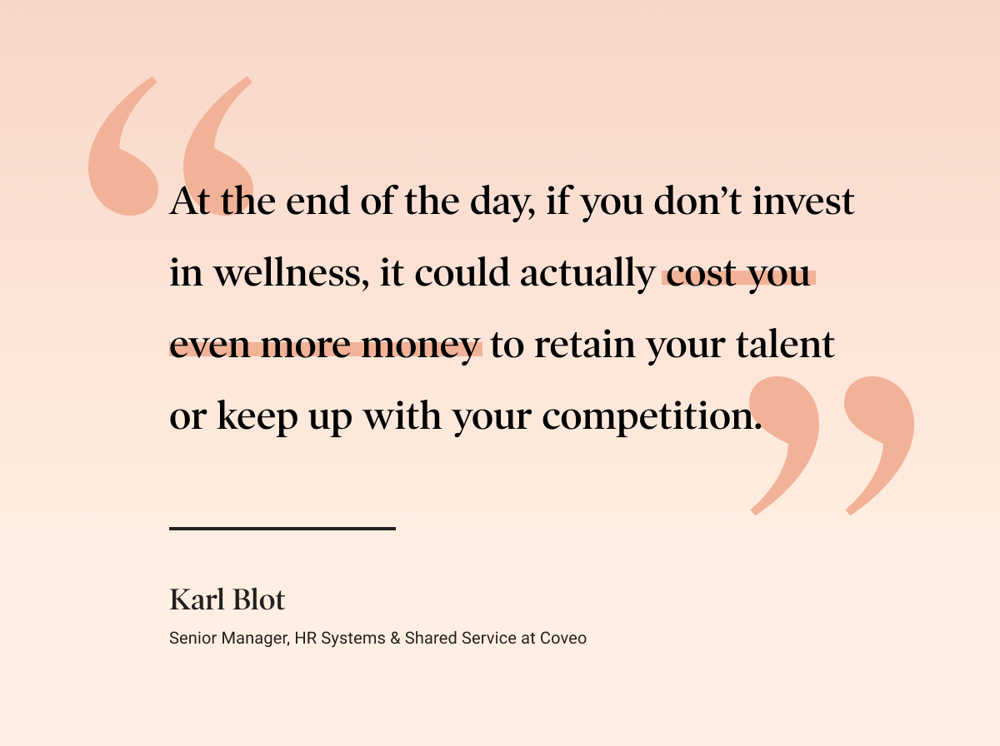With financial uncertainty and rising costs of stress, absenteeism, and disability plaguing the workplace, it's more important than ever for HR leaders to prioritize employee well-being. But they face a unique challenge – how to invest in employee health and wellness when budgets are tight.
We tapped into experts from various industries to find out their strategies for fostering long term health and happiness that won't break the bank. Read on to learn how HR leaders, advisors, and insurance carriers build strong organizations with healthier employees.
This article is a summary of the round table discussion. Click to listen to the complete conversation.


Jump to:
Nachi Bhatia
According to the 2022 LinkedIn Global Talent Trends Report, compensation and benefits are top priority for candidates – above flexibility, work-life balance, and upskilling. But having the right benefits plan is crucial.
In the current economic state, rising expenses associated with workplace stress, absence, and disability aren't uncommon. How do leaders like you continue to put employee well-being first? How can the very real and beneficial financial impact of investing in health and wellness be demonstrated?
Could you set the scene for us and describe what wellness challenges are your employees or clients facing?
Jennifer Foubert
I'll start with the perspective of the continuum of care. We're all on this continuum: from healthy to potentially strained and at risk, such that we may be absent or having a disability experience.
We, as individuals, are moving along that continuum, but so are workforces. With the pandemic, the proportion of individuals in this sustained, strained, and at risk state is increasing. I believe it will be extremely important for organizations who are looking to make an impact to leverage proactive resilience to help mitigate the risk for that subset of the population.
The opportunity to influence and drive people towards wellness and health, and help them adopt positive behaviours will be extremely important. I think that employees are craving this. They're looking for providers who will bring these types of solutions to them.
Karl Blot
There’s life before 2020, and after 2020. Two years ago, we had no one that was in charge of leave management at Coveo. It's a continuum. It's unfortunate, but now more and more, we do have people that go on leaves of absences. And we see that number going up, and the majority of the time, it's for wellness, not necessarily because of work. So we have put a lot of things in place to reduce risk and be proactive. I think that's the number one thing: being proactive.
Barbara Vafopoulous
On Friday the 13th, March 2020, everything changed. I notice things in three parts. You have different pain points for different people in the organization.
Top leadership was really just trying to figure out, “how do I engage my workforce, and then reassure them?” People were worried. So, how do you communicate that you're listening, that you're there for them, but also keep your culture alive? And some people saw a great opportunity to change the culture.
For middle management, they had their own things to figure out, on top of their teams’. So, they had to realign their leadership skills and style. If you ruled by the Iron Fist, well, that wasn't going to work anymore. As HR, we rely heavily now on managers to catch whether people are really okay or not.
Individual contributors have this newfound flexibility. Some are thriving. They're healthier than ever, and they've figured out how to manage it. But a great majority have lost their sense of belonging to your organization or your team. Overall, what we have to remember is there's been a change in routine.

Nachi Bhatia
Those answers make it apparent that it's a tall order. And it's certainly not simple to move the needle within your organization.
According to MaRS, spending on employee benefits annually accounts for about 15% of small business payroll or up to 30% of large business payroll. For organizations that are having financial difficulties or being cautious, employee wellness initiatives may be reduced or removed. However, there is a positive financial impact of investing in wellness. Studies have shown that a focus on wellness can prevent the onset of chronic conditions. And with recommended weekly physical activity, there is 30% less chance of depression or anxiety, which can reduce absenteeism and disability.
How does investing in wellness reduce health-related costs or disability? How does wellness support businesses in a tough economic climate?
Baraba Vafopoulos
It really has to start with a top-down culture that shows employee well-being is a priority. Empathy has a direct correlation with fewer people leaving the organization and fewer people dealing with burnout. Investing in the wellness of our employees leads to business success and profit.
If teammates really feel cared for, they feel valued and invested in, they will stay. However, even if they're leaving, people always remember where they worked and where they felt cared for. So this can also lead to attracting talent, right?
Jennifer Foubert
A Deloitte report suggested that organizations that invest in their people’s health and wellness are some of the best performing on the TSX. Organizations investing along the entire continuum of care also demonstrate the strongest return on investment.
Another key finding was that it took on average three years for many organizations to start to demonstrate that return on investment. So, as you're building your business case, sometimes just staving off that curve is impactful. Then there’s also evidence of the cost of doing nothing, and what the potential impact would be. I really encourage leveraging external evidence as you're building your business case to set the expectations.

Karl Blot
First, big disclaimer, wellness does not mean more money needs to be spent. For example, we've introduced no meetings on Friday afternoon. This means when employees clock out at five, they’ve had time to wind down and not start the weekend feeling overwhelmed. That's zero cost.
It's really about trusting your employees. Wellness has to come from upper management. It cannot be a bottom up solution. Our CEO starts every kick off, every town hall discussing employee wellness metrics. Every quarter we discuss how can we improve.
Mental health, physical health, and financial health are interconnected. If your physical health is an issue, most likely your mental health won’t be good. Jennifer mentioned it: you might not see change overnight. It's an investment for the future, for the long term. Give six months, a year, or a year and a half, to actually see those results.
For companies that might still be resistant to prioritizing wellness due to the financial cost, what advice would you give to HR leaders who need to show the value of investing in wellness?
Jennifer Foubert
Lean on your partners. Lean on your advisors that you're working with. They are equally invested in working with you to build those business cases. Leverage them to help you in your mission to influence the stakeholders that you need to influence. They're deep subject-matter experts in this area. So, bring them in and have them lock arms with you.
Barbara Vafopoulos
Look at your current state, even if over the past two years you had no wellness program. And try to envision the future state. Your purpose. Why do you want to invest in wellness and what do you want it to look like? You have to identify the issues. Look for things like retention rate, absenteeism, or workplace injuries. Survey your people and survey your culture. Or, you might even look at why some candidates have declined job offers.
Find the wellness initiative that you think would really add value to everybody. Then you go to leadership to ask for money. And then you work towards it with your key performance indicators, because you need to look at wellness with a whole person approach.
Karl Blot
Wellness is retention. Tomorrow morning, I could leave for a better job with better pay, right? However, if you offer support for when my kid is sick, or I’m stressed, or not feeling well, I might think twice. If I feel like I can be vulnerable with my peers and my manager, that’s big.
The second thing is to look at stats. When you see your leave management is increasing, well, you have an issue, right? If your people in R&D are sick, there's no product enhancement whatsoever. If you take care of your people, they will stay. Your product and your company, whichever industry you are in, is going to grow naturally. If you don't do it, then you have to invest double or triple in other places.

What should leaders look for in an effective wellness program to strengthen their organization and build a culture of health and happiness in the long term?
Jennifer Foubert
Start with the employee experience and make it easy for them. Some organizations may be just getting started, while others have grown desperate with multiple programs that don’t work together. Sometimes it can be very challenging for employees to find the right help when feeling compromised or vulnerable.
Folks know the value that Dialogue places on integration of services. Look at the best navigation and support that can be offered in an integrated way. Make it easy for them to access the solutions you're making available in one single place.
Communication is so important. If people don't know what's available and how to find it, you're not going to see the desired impact. And we've touched on this a few times, but there’s also leadership endorsement. It's extremely important to ensure the long-term viability of the program
Barbara Vafopoulos
Look at wellness in a larger perspective. If you do want an effective wellness program that will lead to health and happiness, you really first have to do a financial focus on your low earners’ wages. Can they afford living on their wages with what's happening? Because you can have the most wonderful programs, but if these frustrated teammates are financially strained, they can't participate in these initiatives, or they won't want to.
Karl Blot
First, survey. Ask your employees what they want. We have to go out there and ask: “hey, what would you like as a wellness initiative?”
Diversifying is number two. We have yoga classes. We have pilates. We have some boxing class. I'm a big metrics guy. I look at the participation rate. If it's flat, or it's going down, that means what I’m doing is not going well. You got to ask yourself: “how can I modify that offer?” So, focus on diversifying and look at the rates of participation for all your wellness initiatives.
Nachi Bhatia
Prioritizing employee wellness is not only the right thing to do, but it also makes good business sense. We've discussed how crucial it is to provide the right type of support to your employees: benefits programs that are accessible to all and that adapt to different needs.
Organizations who invest in health and wellness programs see a return on their investment in the form of decreased absenteeism, lower disability costs, and fewer chronic health conditions. When employees are healthy and happy, they’re more productive and more likely to stay.
Our panellists agree: organizations that don’t put employee wellness first risk losing talented employees and incurring high costs down the road.
Click here to watch the complete round table discussion.
Take your wellness solution to the next level with Dialogue’s Wellness program.





 Canada (EN)
Canada (EN)
 Global (EN)
Global (EN)






